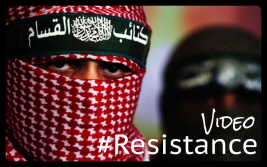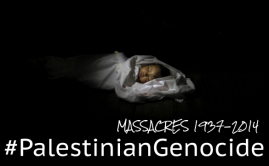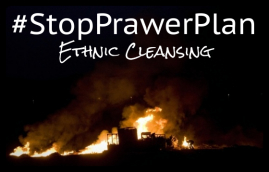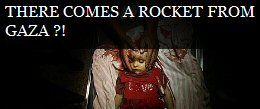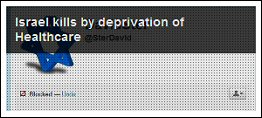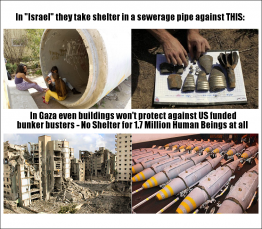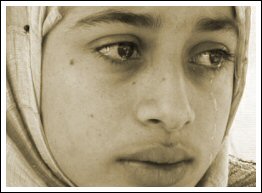SPECIAL TOPIC
“Animals. Animals. Like the Discovery Channel. All of Ramallah is a jungle. There are monkeys, dogs, gorillas. The problem is that the animals are locked they can’t come out. We’re humans. They’re animals. They aren’t humans we are.” – Israeli border police (you can find at 5:03 of this video)
| Welcome to West Bank Palestine: Daily Harrasement, intimidation, discrimination, racism, humiliation, ,denial of humanitarian treatment, respect and even medical aid, women dying at checpoints during labor, or elders in need of medical assistance, violence, interrogations and even killings. Open your eyes and SHARE, so the world witnesses the truth. 65 years ongoing now. It has been enough! |
Violence and Harassment at Israeli Checkpoints.
Watch the rifles pointed at children. People endless waiting. Refused to enter, demolition of property … and more
Checkpoints
- “The right to freedom of movement provides that people are entitled to move freely within the borders of the state, to leave any country and to return to their country.”
- Article 13 of the Universal Declaration of Human Rights and article 12 of the International Covenant on Civil and Political Rights. December 10th, 1948
Movement Restrictions: The Facts
- By September 2008 there were 699 closure obstacles in the West Bank– approximately 130 of these have been added after the Annapolis Conference began in November 2007.
- 630 of the obstacles have been identified: trenches (3%), partial checkpoints (3%), earth walls (7%), road-blocks (11%), road barriers (12%), checkpoints (12%), road gates (16%) and earth mounds (36%).
- 74 % of the main routes in the West Bank are controlled by checkpoints or blocked entirely.
- In the period from April to September 2008 the weekly average of flying (or random) checkpoints was 89. Due to their unpredictable nature and more intensive search procedures, the flying checkpoints are usually even more problematic for the Palestinians than the regular ones.
Movement Restrictions
Over the last forty one years of the military occupation of Palestinian land, Israel has implemented a policy of movement restrictions including checkpoints, earth mounds, trenches, gates, roadblocks, bypass roads, the Wall, and a complex system of permits.
From 1967 to 1991, restrictions on the movement of Palestinians were relatively light. However, with the beginning of the first Intifada in 1987, Israel increasingly restricted Palestinians’ freedom of movement by implementing a permit system; and in 1988, Israel began preventing Palestinians from traveling between the Gaza Strip and the West Bank. With the start of the first Gulf War in 1991, the Israeli Military imple-mented further restrictions on the permit system. Every Palestinian was required to obtain an individual permit, instead of general permits that applied to the population as a whole. In 1993, Israeli military check-points were established along the 1949 Armistice Line between the West Bank and Israel; between the West Bank and East Jerusalem; and between cities within the West Bank.
From the beginning of the Second Intifada in 2000, the Israeli Military increasingly restricted Palestinians from moving freely. In 2001 it became illegal for Israeli citizens to travel into Area A (areas under full Palestinian control) in the West Bank. From 2002 to the present, closure policies have substantially tightened and the entry of Palestinian workers into Israel has drasti-cally decreased.
Israeli and Palestinian security-controlled areas map
Since the onset of the Annapolis Peace Process, there have been no changes in Israeli policy, and in fact a recorded increase in the num-ber of movement restirctions face by Palestinians in the West Bank.
Economic Impact
According to the World Bank, the recession in the Palestinian economy since 2000 is “among the worst in modern history”. The restrictions on freedom of movement that Israel has imposed on Palestinians since the outbreak of the second In-tifada is the primary cause of the decline of the Palestinian economy and chronic increases in unemployment and poverty across the Occupied Territories. Examples of the fragmentation of the local Palestinian economy includes, but are not limited to: economic separation between the West Bank and Gaza, severe limitations on economic interaction with Israel, no access to mar-kets for vendors of perishable products, isolation of markets in East Jerusalem from the rest of the West Bank and a decline in investments due to uncertainty and inefficiency.
A report by the World Bank published in May 2007 stated that economic recovery and sustainable growth within the West Bank would ”… require a fundamental reassessment of closure practices, a restoration of the presumption of movement, and review of Israeli control of the population registry and other means of dictating the residency of Palestinians”.
Access to Health Care
Restrictions on the freedom of movement of Palestinians have seriously affected their access to medical care, including emergency medical treatment. The ability to reach medical care and healthcare is very uncertain and depends on a number of arbitrary decisions and restrictions.
Soldiers at checkpoints consistently stop ambulances and patients. The Palestinian Red Crescent Society, has reported 112 deaths and 35 stillbirths as a result of preventing medical personnel and patients from crossing checkpoints. The World Health Organization deplores “the incidents involving lack of respect and protection for Palestinian ambulances and medical personnel (…) as well as the restrictions on movement imposed on them by Israel, the occupying power, in violation of international humanitarian law”.
Checkpoint Birth
According to the World Health Organization, at least 69 women have given birth at check-points the the outbreak of the Second Intifada in September of 2000 to 2006. These women endure labor in some of the most unsanitary and inhumane conditions possible.
→ 35 babies died (unborn) at checkpoints in Palestine
The risk to themselves and to their babies is grave.Out of these 69 cases recorded by WHO, 35 of the newborns have died and a total of five mothers have also perished. In all of the instances, whether the baby lives or dies, the mother carries deep emotional scars.
As is so often the case, the statistics vary from one source to another. The most recent reliable source has been the UN General Assembly, Annual Report of the UN High Commissioner from the 1st of February 2008, which states that by the time of the meeting, the number of women giving birth at checkpoints remained the same as the year before, i.e. 69 (paragraph 3). However, if you read further to paragraph 6, the report refers to at least 2 more births in December 2007 alone.
Furthermore, There is another case which has been reported to have taken place, but which has yet to be published in the findings of any human rights organization. In all of these cases, neither the state of th mother or the child is known.
The recent case of Halah Yousif, as reported by the Palestine Monitor in October of 2008, is only one example of how this cruel statistic unfolds. This young woman, who was diagnosed with a condition called Toxemia, was not allowed to pass the Erez checkpoint separating the Gaza Strip from Israel, and separating Halah and her child from desperately needed health care. Despite the fact that she had been granted permis-sion from the Israeli authorities to cross, she was not allowed by the border police.
As this book goes to print, we are awaiting news of the fate(s) of her and her unborn child. Though there is a chance that she has received the attention she needed on time, she is only one more story in this most disturbing of statistical categories.
For weekly updates about Palestine and Human Rights, also about checkpoints check the Website of PCHR
They also offer the possibility to subscribe for weekly email newsletter with weekly report updates.
Resources
- Restrictions on Movement and Related Documents | B’ Tselem
- Continuous Watch Reporting & Photography of All West Bank Checkpoints | Machsom Watch
- 71 Palestinian Women Forced to Labor at Checkpoints-Women Denied Access to Hospitals
- B’Tselem: “Permit System to Cross Separation Barrier is Racist”
- Israel Permit System
- Israel’s ID/Permit System an element of Israeli apartheid
Videos
- Checkpoint | Documentary | (8 Parts)
- Women and children treated like cattle | Women & Checkpoints
- Palestinian children ride obstacle course to school | Children & Checkpoints
- Checkpoint in Brussels – Israeli Apartheid Week (IAW) action | Activism | Mar 13, 2011
- Israelis stealing Palestian’s food on way to work






